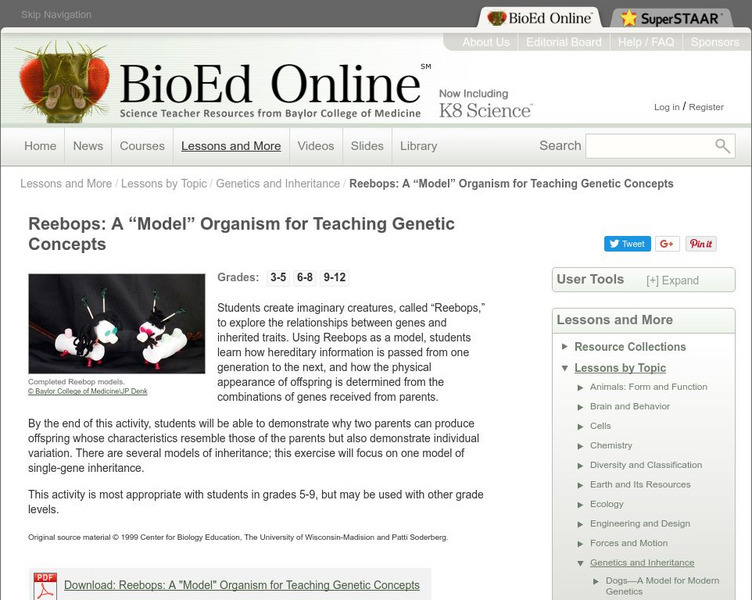Hi, what do you want to do?
Curated OER
Pea Plants Dihybrid Cross
In this dihybrid cross worksheet, students are given four crosses to complete using punnett squares. They determine the genotypic and phenotypic ratios of the offspring.
Curated OER
Heredity
For this science worksheet, middle schoolers find the answers to various types of heredity problems. They use the sheet to set goals for completing the unit.
Curated OER
The Nash Case -- Identifying, Choosing and Using Genes
Students complete a variety of exercises as they examine the case of the Nash family who conceived one child in order to provide cells that may be used in a cell transplant for a dying sibling.
Curated OER
The Empirical Challenges of Racial Classification
This lesson plan will help students examine their preconceptions and assumptions about racial categories and understand the impossibility of constructing a consistent system of human racial classification.
Curated OER
Lesson 16: DNA Technology
Learners research different areas of biotechnology. For this biology lesson, students create a presentation about their research. They debate the topic presented and share their views on the subject.
Curated OER
Drosophila Melanogaster
Students cross wild type flies and mutants, both purchased from a biological supply house (Carolina Biological Supply or Wards, for example) in groups from lesson one.
Curated OER
Simulation of Gene Splicing
Students simulate gene splicing by examining bacteria. They create a bacterial DNA into which they insert the human DNA (gene) that codes for growth hormone. They cut the sites of the enzyme to study how the human DNA can be joined to...
Curated OER
Born of Blood
Eighth graders use a large Punnett Square and infer how genes determine blood types. In this blood type lesson students predict blood types and demonstrate how Punnett Squares are related to genes and chromosomes.
Curated OER
Marshmallow Babies
Eighth graders interpret the genotypes and phenotypes, then pair up chromosomes.
Curated OER
Square Dancing
Fourth graders investigate the concept of using punnett squares in the determination of the offspring.They collect drawings and pictures and create a collection for student science journals.
Curated OER
Chapter 5: Socializing the Individual
In this socializing the individual worksheet, high schoolers respond to 6 multiple choice questions and 14 fill in the blank questions pertaining to how one learns to live within their culture.
Curated OER
Nature vs. Nurture
Eighth graders investigate the concept of nature versus nurture in human development through this series of lessons.
Curated OER
Evolution and Genes
In this psychology worksheet, students complete 5 short answer questions about traits, mutations and the theory of natural selection.
BBC
Bbc: Gcse Bitesize: Genetic Inheritance Aqa
Our genes are inherited from our parents, and the different combinations of these genes make us unique. Genetic inheritance controls the characteristics of all living things. This lesson focuses on the inheritance of biological sex in...
Center for Innovation in Engineering and Science Education, Stevens Institute of Technology
Ciese: Human Genetics Project: Is the Dominant Trait Most Prevalent?
Human-Genetics: A Worldwide Search for the Dominant Trait allows you to collect data and share your results with students around the world. Register your class, complete the student survey, participate in discussion boards, and interact...
BioEd Online
Bio Ed Online: Reebops: A "Model" Organism for Teaching Genetic Concepts
In this lesson students create imaginary creatures, called "Reebops," to explore the relationships between genes and inherited traits. Using Reebops as a model, students learn how hereditary information is passed from one generation to...
PBS
Pbs Learning Media: How Genetic Disorders Are Inherited
Learn how genetic disorders are passed from parents to children as explained in this excerpt from Blazing a Genetic Trail, from the Howard Hughes Medical Institute.
Utah STEM Foundation
Utah Stem Action Center: Inherited Traits
Ever wondered why you might look like your parents? Or an animal cub my look like its mom? Learn about inherited traits with this quick and easy lesson.
PBS
Pbs: Our Genes/our Choices: The Probabilities of Problems: A Look at Inheritance
Learn how the genes inherited from two parents can be recombined in their offspring in this simulation activity. In addition, investigate the probabilities of passing on inherited genetic disorders.
Biology Corner
Biology Corner: Pipe Cleaner Babies
Using chromosome and gene models, students play the roles of two parents in this genetics simulation. The object is to create four offspring and determine their genotypes and phenotypes, and determine the probability of having offspring...
CK-12 Foundation
Ck 12: Life Science: 3.3 Punnett Squares
See how a Punnett square is a special tool used to predict the offspring from a cross, or mating between two parents.
Cold Spring Harbor Laboratory
Dna From the Beginning: Genes Come in Pairs
This animated lesson will explain how genes are inherited in pairs, one from the mother and one from the father.
Oklahoma State University
Oklahoma State University: Ag in the Classroom: Hairy Heredity [Pdf]
A simulation where students flip coins to mimic how parents pass genetic traits to their offspring through heredity. This activity also illustrates the difference between dominant and recessive genes, and how they interact with each...
Science Buddies
Science Buddies: Pedigree Analysis: A Family Tree of Traits
Some characteristics, like the shape of your hairline, whether your earlobes are attached or detached, and whether or not you have freckles are inherited from your parents. In this science project you will learn about Mendelian traits,...
























